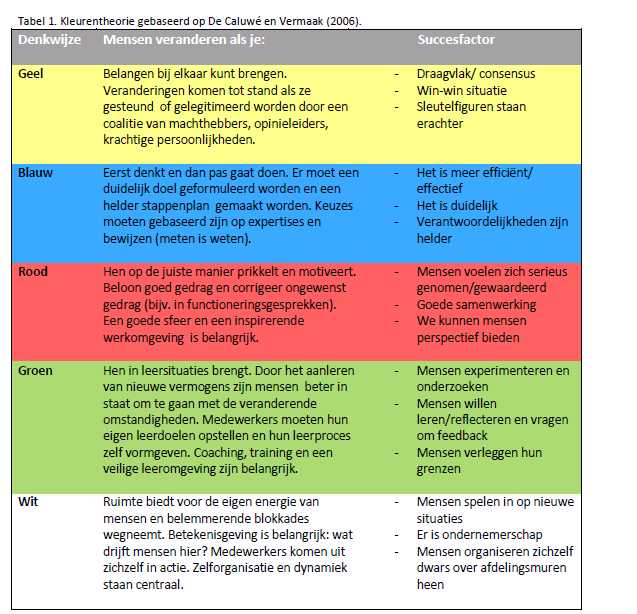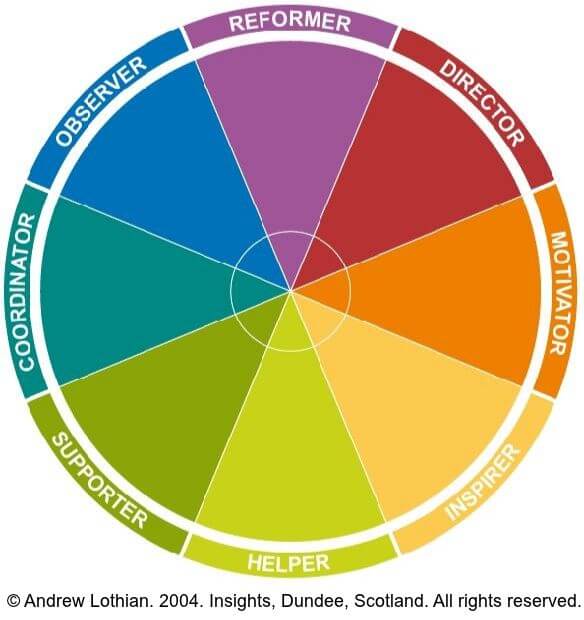Optimal Networking – Incompany
Doing business, commercial success and networking are inextricably linked. Through ...
Are you looking for an approach to change management that takes into account someone's preferences and where there is mutual understanding? The color theory of Caluwé and Vermaak (2006) can help you with this. Do you want to know how you can apply color theory? You can read it in this blog.

Change management within organizations. Every employee sooner or later has to deal with it: change. Sufficient time has been set aside for the preparations for a change, everything has been prepared down to the last detail and then the implementation can begin. Unfortunately, the results of change management are disappointing or even worse: the change process fails. Up to 70% of all change processes in the business world fail and too little is invested to make the changes successful.
What you need is an approach that allows you to implement changes successfully. An approach in which you take someone's preferences into account and there is mutual understanding. The color theory of Caluwé and Vermaak (2006) can help you with this. Do you want to know how you can apply color theory? You can read it in this blog.
We have discussed change management several times in recent weeks. For example, we told you about one in our previous blog approach to change management. And in yet another blog we discussed the different phases of change management.
What exactly is change management? Change management is a form of management that focuses on implementing changes within a company or organization. According to Tiggelaar (2010), the literature on change management focuses too much on the cognitive aspect of people's behavior and will. According to Tiggelaar, behavior is a complex problem that cannot be described in one concept; it is important that you use multiple views on behavior. There are also different views on change. A model that fits different views on change is the color theory.
The color theory is a model developed by professor of consultancy Leon de Caluwé and organizational psychologist Hans Vermaak. The model represents five views on change. Each vision has its own color and therefore reflects an underlying set of beliefs about change. According to Caluwé and Vermaak (2006), there are five different colors: yellow, blue, red, green and white. In the table below you will find per color what the vision on change is and when the change has been successful (the success factor).

For employees who have a yellow vision about change, creating support, bundling interests and creating win-win situations is very important. Key figures such as those in power, opinion leaders or powerful personalities must also support the changes. Yellow-print thinkers believe that everyone acts in their own interests, that there are always hidden agendas. It doesn't matter what someone says, it matters who says it. And not because of what you know, but because of who you know.
For people who have a blue vision about change, efficient organization, detailed specifications, planning and control are very important. The following applies to this group: think first and then act. Do you remember that one employee who determines the result in advance, as well as the route to it: from A to B? That is a blueprint thinker who likes step-by-step plans, manuals and guidelines. Their choices are based on expertise and evidence, because measuring is knowing. According to them, what cannot be measured does not matter.
For employees who look at changes through red glasses, motivating people and the “we feeling” are very important. You must stimulate and motivate this group in the right way. You do this by rewarding good behavior and correcting unwanted behavior. How do you create a “we feeling” among this group? You do this by creating a sense of solidarity among these employees. Good communication, good collaboration and team building are very important. Because according to them, changes can only take place in personal, open and respectful conversations. Showing support, recognition, perspective and respect is essential for red print thinkers.
With these employees, it is important that you put employees in learning situations. Because when you learn you change; and when you change, you learn. Let green print thinkers acquire new skills, adapt to changing circumstances or become aware of their own way of doing and seeing. Because if employees know what they are “consciously incompetent” in, they know what they cannot yet do and they are motivated to invest and work in it. How do you make changes in this green group a success? By providing feedback and also by allowing space for reflection. You can and must learn from your mistakes.Whiteprint thinking
What is typical of the last group: the white-print thinkers? With white print thinkers, employees take action on their own. Self-organization, meaning-making and will formation are key words here. These employees take action based on their motivations and only open themselves up to change when they want it. Do you have a colleague who only does something because he or she wants to? Then there is a good chance that this is a white-print thinker. These employees are difficult to influence and they are creative, innovative and stubborn.
If you have to change, what colored glasses do you look through? When changes take place, everyone looks at these changes from their own colored glasses. Communication between two people wearing red glasses will usually run smoother than, for example, between two people wearing red and blue glasses.
It is important that you realize that all colors are equal. One color is not better or worse than the other. Everyone has their preference to communicate using a certain main color. The trick is to communicate changes with a combination of different colors. A color should be the main approach with which you communicate a clear message. You will then involve the different colors in the change process and communicate from these different colors. For example, by drawing up a plan (blue), negotiating the required budget (yellow), communicating with the target group (red), coaching others (green) and creating space (white).
By communicating from different lenses you can talk to each other better and also talk about change more meaningfully. No one can speak or think without color. However, becoming aware of certain likes and dislikes contributes to a meaningful dialogue. And through meaningful dialogue, there is a greater chance of support. And this also increases the chance of successful implementation of the changes.
Not only during changes, but also in everyday life, you take action based on certain preferences. A model that also uses colors and where you gain insight into yourself and others is the Insights Discovery wheel. This Insights Discovery wheel was developed by Andrew and Andi Lothian and is based on the ideas of Carl Gustav Jung. In the image below you see the Insights Discovery wheel.

The colors refer to behavioral preferences that determine how you react, think and act. Everyone has all the colors within them and the combination of the colors makes us unique as people. Over the years you have developed a preference for certain colors and the context also plays a major role in this. With the color language of InsightsDiscovery you gain more insight into yourself and others. This way you learn where your qualities and development points lie. You also learn to recognize the colors of colleagues and this ensures, among other things, more mutual understanding, more effective cooperation and better communication.
How can you ensure that your employees respond successfully to changes? You do this by using InsightsDiscovery. Each individual responds differently to change and with Insights Discovery you gain insight into the preferences of your employees. Before, during and after the changes you speak in the different color languages of your team. By speaking in different color languages, employees feel heard, they are more involved and more inclined to make a positive contribution to the changes. A personal approach is therefore essential in change management and Insights Discovery makes an important contribution to this.
Do you want to know how you can show your colors in your change process? Or do you not know which change process is suitable for you? We are happy to help you on your way Business Improvement #Change2success
Sources
De Caluwé, L. & Vermaak, H. (2006). Learning to change: a handbook for the change expert. Deventer: Kluwer.
Tiggelaar, B. (2010). The Core of the Matter: Feasibility and effectiveness of behavioral dual system interventions for organizational change. Soest: Tyler Roland Press.